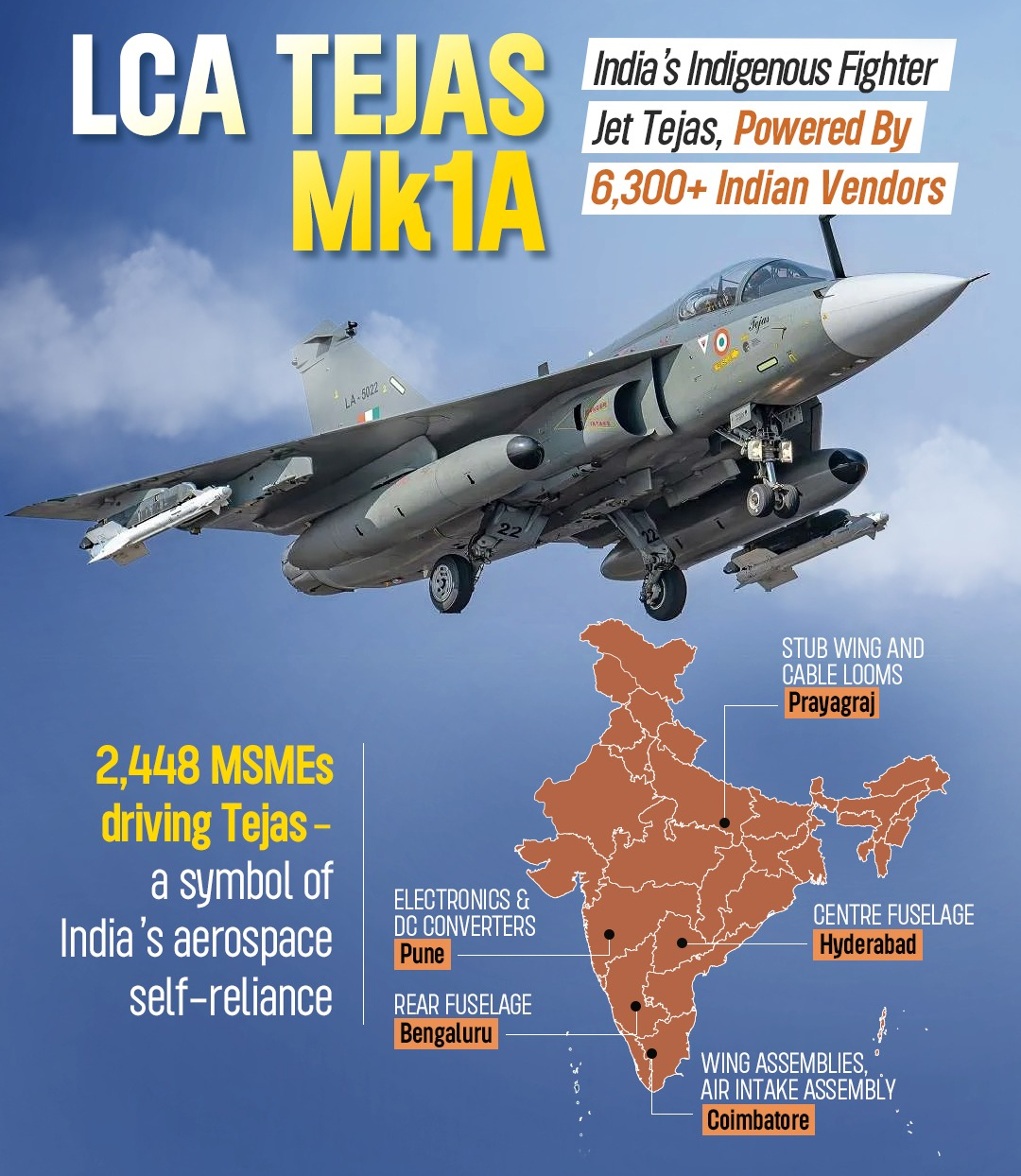Context:
On 25 September 2025, the Ministry of Defence signed a major contract with Hindustan Aeronautics Limited (HAL) for the procurement of 97 LCA Tejas Mk1A fighter aircraft for the Indian Air Force (IAF). The deal, worth ₹62,370 crore, is a significant step in India's efforts towards military modernization and self-reliance.
About the deal:
The order includes 68 single-seat fighters and 29 twin-seat trainer aircraft, with deliveries scheduled to begin in 2027–28 and completed over six years.
· The procurement falls under the ‘Buy (Indian-IDDM)’ category of the Defence Acquisition Procedure (DAP) 2020, emphasizing indigenous design, development, and manufacturing.
About Tejas Mk1A:
-
- Tejas Mk1A is an upgraded version of the LCA Tejas Mark‑1 developed by ADA (Aeronautical Development Agency) and manufactured by HAL (Hindustan Aeronautics Limited) for the Indian Air Force (IAF).
- It builds on the Mk1 model with several enhancements in avionics, radar, electronic warfare, maintainability, and indigenous content.
- Tejas Mk1A is an upgraded version of the LCA Tejas Mark‑1 developed by ADA (Aeronautical Development Agency) and manufactured by HAL (Hindustan Aeronautics Limited) for the Indian Air Force (IAF).
Key Upgrades & Features:
1. Radar & Sensor Suite
o The first ~40 Mk1A jets will use the Israeli EL/M‑2052 AESA radar.
o There after “Uttam” AESA radar (developed indigenously by DRDO/BEL/HAL) will be integrated.
o Uttam features ~912 transmit‑receive (TR) modules, multi‑mode operations (air‑to‑air, air‑to‑ground etc.), better target tracking, and superior electronic warfare performance.
2. More Indigenous Content & Avionics
o Mk1A has ~50% more indigenous content compared to Mk1.
o Integration of an indigenous digital fly‑by‑wire flight control computer (DFCC) in the LSP‑07 prototype, improving flight control, handling and maneuverability.
3. Electronic Warfare / Survivability
o New EW suite including Radar Warning Receiver (RWR), advanced self‑protection jammer pods and better situational awareness systems.
4. Weapon Integration & Hardpoints
o Better weapon carriage: ~9 hardpoints for a mix of air‑to‑air, air‑to‑ground munitions, including Beyond‑Visual‑Range (BVR) missiles and ASRAAM.
o Capability to integrate precision‑guided munitions and ground attack roles in addition to air defence.
The aircraft will have over 64% indigenous content, with 67 new indigenously developed components added compared to the 2021 contract. This move strengthens India’s defence manufacturing ecosystem and supports the Atmanirbhar Bharat initiative.
Strategic & Economic Importance:
-
- The Mk1A jets will help replace India’s aging MiG-21/23/27 fleet, address fighter squadron shortages, and improve combat readiness.
- The contract will involve around 105 Indian companies and is expected to generate over 11,000 jobs annually, giving a boost to the Indian aerospace sector.
- Additionally, the indigenous platform enhances strategic autonomy, reduces foreign dependency, and may open export opportunities, boosting India’s profile as a defence exporter.
- The Mk1A jets will help replace India’s aging MiG-21/23/27 fleet, address fighter squadron shortages, and improve combat readiness.
Conclusion
This contract is a strategic milestone that merges national security priorities with industrial development. If executed efficiently, it will enhance the IAF’s capabilities, promote indigenous innovation, and solidify India’s position as a credible defence manufacturer on the global stage.







